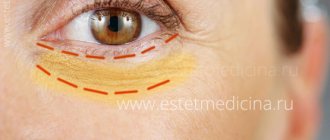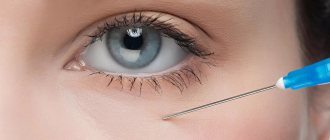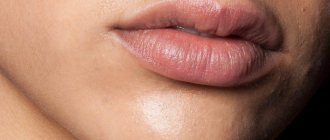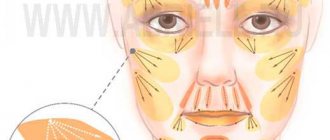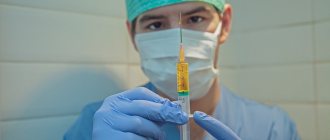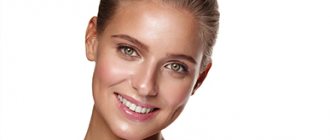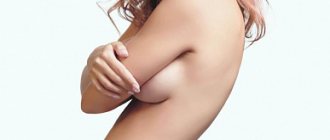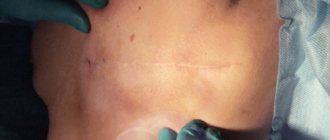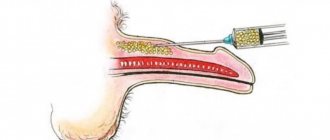Why do many patients choose lipofilling if it is necessary to restore the volume and contours of the face? The answer is simple: this is one of the most physiological methods. It's worth explaining in more detail.
Firstly, the transplanted fat is not rejected by the body, because after injection into problem areas it retains its natural properties and characteristics and is perceived as “native” material. There should not be an allergic reaction after lipofilling for the same reason.
Secondly, facial lipofilling attracts with a wide range of possibilities. After transplantation, your own fat triggers natural rejuvenating processes due to the stem cells in its composition. After the procedure, we get perfectly smooth young skin without cavities, age folds and pronounced wrinkles.
The popularity of lipofilling is due to the physiology and safety of this technique. After the procedure there is a short rehabilitation: patients tolerate it easily and recover quickly.
What is lipofilling
Carrying out lipofilling of the nasolacrimal groove is a procedure for correcting and rejuvenating this area, eliminating deep grooves and sagging tissue. The condition of the skin improves, the skin is tightened and smoothed. Manipulations can be carried out either using micro-incisions or by injecting adipose tissue through a series of micro-injections. Only a cosmetologist can determine the method of administration, after a detailed analysis of the treated area, examination of the patient and exclusion of all contraindications. The injection method is less invasive, but the results are less pronounced and lasting; the surgical technique gives a longer lasting result.
The skin in the lower eyelid area is very thin; the injected fat, if handled ineptly, can form lumps and appear. Therefore, it is important to choose an experienced specialist who knows all the techniques for performing manipulation and will select it individually for each patient.
Sometimes adipose tissue is enriched with platelet mass taken from the patient’s own blood before injection. It helps tighten the skin, eliminate age-related changes and stimulate rejuvenation.
Benefits of facial fat grafting
- Low-traumatic method with short rehabilitation. It takes only 2-3 months for tissue engraftment. The disappearance of visible consequences of the intervention is already 7-10 days after the procedure.
- There is no need for general anesthesia. Typically, facial lipofilling is performed under local anesthesia.
- A natural result of facial rejuvenation and transformation. There is no mask effect, which many fear. After lipofilling, the skin will look firm and radiant. At the same time, due to the restoration of volumes, the contours and oval of the face will improve.
Disadvantages of lipofilling you should know about
I do not recommend lipofilling in all situations. In case of severe ptosis of the soft tissues of the face, the effect of a double chin, or significant changes in the oval shape, it is best to perform a surgical facelift. I also use advanced techniques for her. One of the most popular today is a total facelift.
Among the disadvantages of lipofilling, it is also important to note the duration of the effect. If after a facelift you can count on long-term rejuvenation results (on average from 10 to 20 years), then after lipofilling the effect can last for 1.5-3 years.
The injected fat is naturally excreted over time. The speed of this process depends on the metabolism in the patient's body. However, this procedure can be repeated if you want to prolong the effect. It is safe!
Indications and contraindications for the tear trough lipofilling procedure
Although there are not many indications for this procedure, they are all serious and help in solving many aesthetic problems:
- “bags” under the eyes are eliminated;
- asymmetry in the area of the nasolacrimal grooves on both sides is corrected;
- the skin is rejuvenated and tightened in the injection area, which reduces age-related changes;
- the symmetry of the treatment areas is restored if there was tissue injury or unsuccessful previous intervention;
- existing folds, furrows and wrinkles in the treatment area are removed.
Thus, lipofilling helps not only in the fight against signs of age, but is a good option for minimally traumatic correction of facial defects, congenital or acquired asymmetry.
However, this procedure is invasive, so there are a number of contraindications to its implementation. They are due to the fact that the intervention can affect the general state of health; if contraindications are ignored, complications may arise.
Main contraindications:
- allergy to anesthetics used during the procedure;
- formation of a hernia in the lower eyelid;
- serious pathologies of internal organs;
- age-related features that provoke a decrease in elasticity, a sharp thinning of the skin in the manipulation area, as well as the risk of melting fat deposits;
- deep fibrosis on the facial skin, extensive scarring;
- young age (manipulations are not performed on persons under 18 years of age);
- pronounced paint bags in the lower eyelid area;
- severe skin ptosis, tissue atrophy in the facial area;
- serious vascular lesions, including atherosclerotic ones;
- violation of integrity in the area of the orbital septum;
- recent manipulations during which various substances were injected into the area of the lower eyelid and skin in the area of the nasolacrimal groove;
- facial skin infections and general infections, acute respiratory viral infections, fever;
- oncology;
- blood pathologies;
- presence of diabetes mellitus.
Before the intervention, the doctor can additionally identify contraindications that can lead to negative results and postpone the procedure until they are eliminated. Sometimes the effect will ultimately depend on the quality of the manipulation itself and the characteristics of the body.
Lipofilling: myths and reality
I recently read an article in which a cosmetologist compares lipofilling with filler and describes lipofilling as a highly traumatic procedure with a long rehabilitation period.
As a surgeon, I see that readers are being misled intentionally or out of ignorance, and therefore it would be good to clarify about these methods of correcting age-related changes.
And first of all, where I would like to start – they are completely different! For the simple reason that lipofilling is a transplantation of one’s own fat, and modern fillers based on hyaluronic acid are a product of microbial synthesis. From this it turns out that transplanted own fat will never lead to allergies, while artificial hyaluronic acid, despite many degrees of purification, can cause a response from the body, although in rare cases.
Lipofilling allows you to obtain a complex effect, which consists of several factors. Firstly, it is replenishment of the lost volume of soft tissues with one’s own fat cells. Secondly, these are stem cells that are taken from the patient along with fat. Stem cells allow you to start skin rejuvenation processes and thereby improve its quality (small wrinkles are smoothed out, skin color becomes fresher and more hydrated). A nice bonus is that the skin above the fat collection area is tightened, just like after liposuction.
A relative disadvantage of lipofilling is the fluctuation in the survival rate of fat cells, which varies from 30 to 80 percent. This variation is associated with the capriciousness of fat cells and the characteristics of the body as a whole, as well as the bad habits of the patient himself, for example, smoking. Therefore, additional lipofilling sessions may be required. Those fat cells that take root remain for almost a lifetime. While hyaluronic acid is absorbed after an average of a year, or even less.
Despite all its shortcomings, hyaluronic acid is irreplaceable if the patient does not have enough body fat to perform lipofilling. Contour plastic surgery with hyaluronic acid is, first of all, a procedure that is well tolerated by patients, requires less time to prepare and perform, and does not require laboratory tests. The final result is visible after 2 days, while with lipofilling it takes a month.
Lipofilling has a wide range of uses in plastic surgery: it can be reconstruction of the mammary glands, as a replacement for an implant or an addition to it for breast enlargement, to smooth out facial wrinkles, improve the appearance of postoperative scars, lip augmentation, rejuvenation of the hands, correction of the shape of the buttocks , shins, as well as in intimate plastic surgery.
The rehabilitation period takes several days; first, swelling appears in the area of fat injection, which disappears by the seventh day. Small bruises may appear, which gradually disappear within a week. In general, the operation is low-traumatic, so complications are rare. After lipofilling, no visible scars are formed.
Lipofilling is an absolutely safe and accessible way to improve the quality of life for every person.
Shevchenko A.G.
Preparation for the procedure
With proper preparation and lipofilling of the nasolacrimal groove, the effect is visible almost immediately. Final results become visible within 3 to 8 weeks. An additional series of injections is possible until a lasting result is achieved. But it is important to prepare for the procedure in advance.
Before the intervention, a doctor’s examination and a full examination are necessary to exclude contraindications. A week before the intervention, blood thinning medications are discontinued, alcohol is not taken, and the face is not exposed to aggressive procedures or external influences. Three hours before the intervention you need to stop eating and drinking.
Body fat grafting
Lipofilling is the use of a patient’s fat to add volume to the breasts and buttocks, form attractive body contours, and restore or rejuvenate the face.
Fat is collected using cannulas - thin tubes - through small incisions on the body. Typically, this occurs during the liposuction process. It is then filtered and the fat cells are isolated. These cells fill the area whose volume needs to be increased.
Pros of lipofilling
- Safe. Reduces the likelihood of scarring.
- Effective. Along with adding volume, it improves the quality and elasticity of the skin.
- Your body fat, unlike implants, eliminates the possibility of allergic reactions to foreign substances
- The results are long lasting and the body looks natural
- Non-invasive procedure for facial rejuvenation
Who needs lipofilling and why?
For men and women who want to transform their face, chest, arms, buttocks or whole body.
Most often, patients come to our clinic for lipofilling with the following requests:
- Breast enlargement. The procedure is suitable for anyone with good breast shape and skin elasticity.
- Restore the beauty and youth of your face: minimize wrinkles between the nose and mouth, reduce crow's feet or folds on the forehead, correct cavities or indentations in the skin
- Adjust body contours
- Conceal residual breast irregularities after implantation to obtain an even contour and optimal shape
- Breast reconstruction after surgery
- Enlarge your buttocks without an implant
- Hand rejuvenation, reduction of wrinkled areas, improvement of skin quality
How is the lipofilling procedure performed?
- The areas from which the fat will be collected are determined. For example, from the buttocks, hips, neck, abdomen, back, arms.
- For a small amount of work, the procedure is performed under local anesthesia. For large volumes - under general.
- The procedure lasts 1-3 hours. The duration depends on the amount of fat that needs to be transferred.
- Fat is collected using cannulas with a diameter of 2-3 mm (thin tubes) through small (only 5 mm long) incisions in the folds of the skin, which over time become almost invisible.
- The fat is filtered and the fat cells are separated from the water and oil.
- Fat cells are transferred to the correction site. The incisions are covered with special bandages.
- You will be escorted to the recovery room.
Contraindications for lipofilling
- Age up to 18 years
- Diabetes
- Cardiovascular diseases
- Oncology
- Bleeding disorder
Lipofilling results: before and after photos
The effect lasts for a long time when the operation is performed by an experienced surgeon.
You can see all the results of the work of surgeons at the New World Surgery clinic below.
How to prepare for the lipofilling procedure?
- Sign up for a free consultation
. - During the consultation, you will talk about your medical history, previous surgeries (if any), and answer a few questions from the surgeon.
- You will discuss your expectations and lipofilling options with your plastic surgeon. According to scientific research, 30 to 75% fat survives. It may take 2-3 lipofilling procedures to achieve the desired result.
- The doctor will explain what tests you will need to take and what results you can expect.
- You will need to exclude those medications that the doctor recommends, and also stop smoking (if you smoke). Smoking slows down the healing process of wounds.
How much does lipofilling of the breasts and buttocks cost in Moscow?
The cost varies from 75 thousand to 200 thousand rubles. The price is determined depending on which areas require adjustment. You can see the full price list for the clinic’s services below.
Everything you need to know about lipofilling
How many days will you be in the hospital?
2-3 days.
Do you need a vacation?
Yes. We recommend taking at least 1 week off. Painful sensations persist for 3-5 days after surgery. This is a minimally invasive procedure, but still an operation. Rest will be required.
How will the rehabilitation proceed?
1 week - the body begins to recover.
Week 2 - residual swelling at the surgical sites.
Day 10 - significant improvement in well-being.
Week 3 - almost complete restoration of appearance.
1 month - you can return to your normal lifestyle.
6 months – final effect.
Will there be scars after lipofilling?
The only scars that will remain are those from liposuction. Lipofilling (filling soft tissues with fat) does not leave scars.
Liposuction incisions are made small, so the scars are also small and are often located in hidden areas. The extent of scarring depends on the surgeon's technique and your genetic tendencies.
Most liposuction scars are virtually invisible.
What complications can lipofilling cause?
Complications from fat grafting are extremely rare.
Lipofilling is performed by experienced surgeons at the New World Surgery clinic. The results of the procedure are already pleasing to dozens of our clients.
